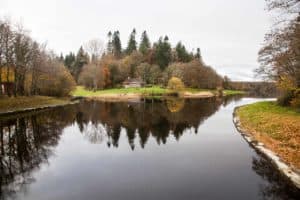Bhutan’s Mountain Fortresses: Castles of Celestial Architecture in the Sky

Updated On: April 17, 2024 by Raghda Elsabbagh
Perched on rugged cliffs and cloaked in mists of legend, Bhutan’s mountain fortresses are magnificent reminders of a rich cultural heritage that blends with the natural splendour of the Himalayas. Known as dzongs, these fortresses are not only feats of architectural wonder but also hold the essence of Bhutan’s history and spirituality within their imposing walls. As we explore these majestic structures, we unveil stories of a bygone era that continue to resonate in the daily lives of the Bhutanese people, reflecting customs and traditions that are deeply intertwined with the nation’s identity.

Bhutan, with its unique philosophy of Gross National Happiness, offers a tapestry of experiences woven from the threads of culture, religion, and biodiversity. The dzongs stand as sentinels to this philosophy, housing monastic bodies and serving as administrative centres, all the while drawing visitors from around the globe. The country’s commitment to conservation and sustainable tourism is evident as one travels through pristine landscapes to reach destinations like the iconic Tiger’s Nest, clinging to the cliffside and inspiring awe and spiritual reflection.
Table of Contents
The Historical Significance of Bhutan’s Mountain Fortresses

Bhutanese mountain fortresses, or Dzongs, are not only architectural marvels but also repositories of the country’s spiritual and administrative history. These fortresses embody the fusion of strategic military design and Buddhist religious functions.
Tiger’s Nest Monastery
Location: Paro Valley
Founded by: Guru Rinpoche
Significance: Tiger’s Nest Monastery, perched on a cliff 3,120 metres above sea level, is a pilgrimage site believed to be the meditation ground for Guru Rinpoche. It is a symbol of sanctity and the introduction of Buddhism to Bhutan.
Punakha Dzong
Location: Punakha District
Constructed: 1637-38
Significance: Punakha Dzong, the second oldest and second-largest dzong in Bhutan, was the administrative centre and the seat of the Government of Bhutan until the capital was moved to Thimphu. It stands as a testament to the unification of Bhutan as a nation-state and is the winter residence of the Dratshang (Central Monastic Body).
Trongsa Dzong
Location: Trongsa District
Constructed: 1644
Significance: Situated strategically atop a mountain spur, Trongsa Dzong serves as a vigilant guard over the crossroads in the heart of the nation, historically controlling the east-west trade. It is intricately linked to the royal family of Bhutan and traditionally serves as the place where the future king is appointed as the Penlop (Governor) of Trongsa.
Geography and Landscape
Bhutan’s fortresses, known as dzongs, are as much a result of the nation’s topography as they are of its history. We find an intricate tapestry of mountain ranges and steep valleys, with the Himalayas cradling the country in their high-altitude embrace.
Cliffside Constructions
The architecture of Bhutan has masterfully turned its vertiginous topography into an advantage. These cliffside constructions are not only marvels of engineering but also act as sentinels gazing over the Paro Valley. For example, the famed Taktshang Goemba — or the Tiger’s Nest Monastery — clings to granite cliffs and overlooks a mesmerising drop of approximately 900 metres (2,953 feet).
The Himalayan Terrain
Bhutan is a land dominated by the Himalayan terrain. The mighty peaks, such as Mount Jomolhari at over 7,300 metres (23,950 feet), serve as natural fortifications for these mountain fortresses. This harsh and rugged terrain varies greatly in elevation, often making these sites accessible only by strenuous treks. The altitude of Bhutan’s dzongs not only provided them with protection but also with panoramic views of the surrounding Himalayas and valleys, with many located at an altitude surpassing 2,000 metres (6,561 feet).
Architecture and Design
In understanding Bhutan’s mountain fortresses, it’s crucial to note the marriage between form and function, where every structure is steeped in historical significance and spiritual essence.
Dzongkha Style
Dzongkha, the architectural language of Bhutan, is epitomised by its iconic dzongs, serving both as monastic and administrative hubs. Often located on strategic vantage points, these fortresses are characterised by their massive walls that stand as testimony to the Bhutanese emphasis on strength and stability. For instance, the Jakar Dzong, also known as the ‘Castle of the White Bird’, exemplifies the Dzongkha style with its commanding position above the Chamkhar valley. Its design adheres to the traditional Bhutanese style, where functionality and aesthetic beauty are interwoven seamlessly.
- Notable features:
- Exterior: High, inward-sloping walls
- Materials: Stone, timber, and rammed earth
- Roofs: Sloping and often layered with wood
Spiritual Symbolism
The design of Bhutanese architecture is deeply infused with spiritual symbolism, culminating in spaces that reflect Buddhist philosophy. The layout and orientation of the dzongs themselves are influenced by Buddhist concepts, serving as a physical manifestation of the country’s ingrained spirituality. Each structure is meticulously crafted to serve not only as a fortress but also as a sacred space for contemplation and religious practice. Structural elements carry symbolic meaning—for instance, the inward-sloping walls not only fortify but also symbolise the inward journey of Buddhist practice.
- Symbolic elements:
- Internal structure: Reflecting Buddhist teachings and hierarchy
- Decor: Colourful motifs that have religious significance
By appreciating the dzongs of Bhutan, we grasp a pivotal chapter of Himalayan architecture, where every stone and timber piece tells a story of religious devotion and historic might.
Cultural Heritage

In Bhutan, the concept of culture stretches beyond simple customs and practices; it embodies the soul of the nation, interwoven with spiritual traditions and historical depth. It is through festivals, local customs, and preservation efforts that Bhutan’s cultural heritage is celebrated and sustained.
Festivals and Celebrations
Bhutan’s calendar brims with festivals or tsechus that honour the teachings of Guru Rinpoche, a figure synonymous with Tibetan Buddhism. One of the most vibrant examples is the Paro Tsechu, where masked dances and religious dramas unfold. This auspicious event gathers communities together, reinforcing solidarity and imparting ancient narratives.
Local Traditions
Traditions run deep in Bhutanese culture, one of which is embodied by the fertility temple Chimi Lhakhang. Pilgrims flock to this site, seeking blessings and partaking in local lore. Moreover, the concept of Gross National Happiness shapes daily life, prioritising holistic well-being and cultural depth over mere economic indicators.
Cultural Preservation
Preserving the Bhutanese way of life is pivotal. Dzongs, once mountain fortresses, now serve as epicentres of governance and monastic life. They stand as firm as ever — not just in structure but as repositories of culture, safeguarding the heritage and spiritual practices that form the backbone of Bhutan.
The Spirit of Adventure
Bhutan’s mountain fortresses are not only a testament to the kingdom’s historical ingenuity but also an invitation to adventure enthusiasts seeking to explore the heights of the Himalayas. Our treks to these ancient sites offer a blend of cultural immersion and natural splendour as we follow trails once walked by monks and warriors alike.
Trekking to the Tiger’s Nest
Paro Taktsang, commonly known as the Tiger’s Nest, is perched precariously on a cliff 900 metres above the Paro Valley. Trekking to this sacred monastery is a rite of passage for visitors that encapsulates the essence of Bhutan’s adventurous spirit. The journey begins in the valley and ascends through whispering pine forests, filled with the chant of prayers and the flutter of prayer flags. It’s a rigorous hike, taking approximately 5 hours round trip, but our expert guides ensure a safe and memorable experience.
Other Notable Hikes
Apart from the well-trodden path to the Tiger’s Nest, Bhutan offers numerous other hikes that promise adventure and solitude. For tourists seeking less congested trails, the Druk Path Trek connects Paro to Thimphu, providing panoramic views across the Himalayas. Each step on these hikes is an intimate encounter with Bhutan’s formidable landscapes and an opportunity to witness the serene lifestyle of mountain communities. Through these experiences, we don’t just journey through space but also step back in time, gaining insight into a way of life preserved for centuries.
Religion and Spirituality

As we cast an eye over Bhutan’s mountain fortresses, the intertwining of religion and spirituality with these monumental structures becomes undeniably evident. Our journey through the sacred highlands of this Himalayan kingdom reveals a deep spiritual tapestry woven through the architecture and practices within these fortress walls.
Buddhism in Bhutan
Buddhism is not just a religion in Bhutan; it’s the very essence of Bhutanese cultural and national identity. Monasteries, often part and parcel with fortress complexes, stand as a testament to the country’s devotion. One cannot overlook the Taktsang Monastery, famously known as the Tiger’s Nest, which appears to defy gravity, perched on the face of a sheer cliff. This iconic temple complex is a profound example of the intrinsic link between Bhutanese spirituality and the natural world.
Sacred Sites
The ubiquitous presence of prayer flags characterises venerated sites across Bhutan. These colourful banners carry manifold blessings and prayers, billowing with the mountain winds. Most temple complexes and monasteries in Bhutan are not singular buildings but extensive complexes, often fortified and at times enveloping entire mountain ridges. Among these majestic settings, the sacredness pulsates, with spirituality woven into the very stones and paths that encircle the foundations.
Fauna and Flora

In the elevated realms of Bhutan, a distinct tapestry of wildlife and vegetation weaves itself amongst the mountain fortresses we call home. Our fortresses stand as silent sentinels amidst a kingdom teeming with unique species and lush forests, underscoring our commitment to environmental conservation.
Native Wildlife
Bhutan’s fauna is a testament to the ecological richness of our Himalayan sanctuary. Forests stretch over vast expanses, providing a home to elusive Takin, Bhutan’s national animal — a stout-bodied relative of the muskox. These creatures roam the higher altitudes, grazing in the company of red pandas and snow leopards, epitomising the wonder of our highland biodiversity.
Our avian population is equally notable, with an array of species that animate our skies and contribute to the symphony of sounds within our forests. The calls of hornbills and the sight of the majestic black-necked crane are among the experiences that make these forests so otherworldly.
Forest Conservation
The fortitude of our forests stands undiminished, thanks in part to our collective efforts in environmental conservation. Bhutan’s constitution mandates a minimum of 60% forest cover, a law abided by to ensure the sustainability and vitality of our ecosystems. As a result, Bhutan not only maintains its natural heritage but also contributes positively to the planet, acting as a carbon sink.
Beyond policy, we have fostered a sense of guardianship over these lands. Traditional practices and respect for nature coalesce to form the bedrock of our conservation ethos. By nurturing the flora and sustaining the fauna, we continuously cultivate our bond with the mountains, affirming our role as stewards of this ancient and venerated landscape.
Economy and Tourism

In Bhutan’s pristine mountain landscape, its economy intertwines with tourism in ways that honour sustainability and cultural preservation. Our focus on economic benefits aligns with our identity as a carbon-negative country, achieved through mindful tourism practices.
Travel Industry Impact
The travel industry in Bhutan significantly bolsters our economy with a focus on a high-value, low-volume model. This ensures that while economic gains are made, they don’t come at the expense of our environment or culture. Rules and regulations set by the government require visitors to pay a Sustainable Development Fee, which supports both conservation efforts and the local communities. Additionally, tourism has prompted the restoration of our ancient fortresses, allowing them to stand proudly as a celebration of our history.
Sustainable Practices
Our commitment to sustainability is reflected in every aspect of the tourism experience in Bhutan. As a carbon-negative country, we ensure that our tourism infrastructure and policies enhance our environmental commitments. Working with tour operators, we underscore the importance of responsible travel, from the transport we use to the trails we tread. We promote practices that support local economies by encouraging visitors to engage with and support native artisans and service providers. It is our aim to make tourism not only a source of economic prosperity but a catalyst for preservation and sustainability.
Visiting Bhutan

Discovering Bhutan’s mountain fortresses involves careful planning to meet entry requirements and choosing the optimal time for your visit.
Entry Requirements
We must secure a visa to visit Bhutan, and it is usually arranged through a registered tour operator. Indian, Bangladeshi, and Maldivian nationals can obtain a visa on arrival. However, all visitors must book their trip through a Bhutanese tour operator or international partner, paying an inclusive daily package that contributes to the Sustainable Daily Fee (SDF). The SDF is a policy to ensure that tourism is eco-friendly and beneficial to the local economy.
For entry, the primary point is the Paro International Airport, renowned for being situated among steep mountain slopes. Ensure your passport is valid for at least 6 months beyond your planned date of departure from Bhutan.
Best Times to Visit
There are two ideal periods to visit Bhutan, catering to various interests:
- Spring (March to May): Blossoms and moderate temperatures create a vibrant landscape, perfect for attending Paro Tshechu, a major religious festival.
- Autumn (September to November): Crisp and clear skies provide optimal conditions for trekking and appreciating the view of the Himalayas.
Tourist influx usually peaks during these times, so plan your trip well in advance. Tour costs vary seasonally, but you can expect to pay the SDF plus your package fee, which includes accommodation, transportation, a guide, and meals. Your tour operator will detail these expenses, as well as the rules and regulations that govern visits to Bhutan’s significant cultural sites.
Frequently Asked Questions

We’ve gathered some of the most common questions about Bhutan’s mountain fortresses and provided concise, informative answers to feed your curiosity and enhance your understanding of these majestic structures.
What is the historical significance of Bhutan’s mountain fortresses?
Bhutan’s mountain fortresses, known as dzongs, are not only architectural marvels but also hold great historical significance. They have served as administrative centres, monastic schools, and defence mechanisms against invasions throughout the centuries.
How can one access the mountaintop fortresses in Bhutan?
The access to Bhutan’s mountaintop fortresses varies, from well-trodden paths to more secluded routes. Some, like the famed Tiger’s Nest Monastery, can be reached by hiking through spectacular forested paths or, for devotees, via a southern path.
What are the architectural highlights of Bhutan’s fortress monasteries?
The architectural highlights include towering exterior walls, intricate wooden carvings, and a harmonious blend of defensive features with monastic spaces. Inside, one can find beautiful courtyards, temples, and living quarters, all built with a deep reverence for traditional Bhutanese styles.
During which period were the majority of Bhutan’s fortresses constructed?
The majority of Bhutan’s fortresses were built during the 17th century when the Drukpa lineage of Buddhism became the dominant religious influence in the country and required strongholds that could serve both religious and administrative functions.
Are there any conservation efforts in place to preserve Bhutan’s mountain fortresses?
Indeed, there are numerous conservation efforts, some supported by international organisations, focused on preserving the structural integrity and cultural significance of Bhutan’s dzongs. These efforts aim to safeguard these sites for future generations.
Which Bhutanese fortress is considered the most iconic, and why?
The Tiger’s Nest Monastery is considered Bhutan’s most iconic fortress due to its precarious location on a cliffside and its legendary founding, connected to Guru Rinpoche, who introduced Buddhism to Bhutan. Its cultural and spiritual significance is unmatched.






